Файл: Учебное пособие Астрономия. Космическая техника и технологии Алматы, 2012 удк 802. 0 52 629. 7 (0758) ббк 81. Англ. 923.docx
ВУЗ: Не указан
Категория: Не указан
Дисциплина: Не указана
Добавлен: 16.03.2024
Просмотров: 97
Скачиваний: 0
ВНИМАНИЕ! Если данный файл нарушает Ваши авторские права, то обязательно сообщите нам.
The ___ planets (those planets that orbit close to the Sun) are quite different from the outer planets (those planets that orbit far from the Sun). The inner planets are Mercury, Venus, ___, and Mars. They are relatively small, composed mostly of ___, and have few or no moons. The outer planets are Jupiter, Saturn, Uranus, Neptune, and Pluto (a dwarf planet). They are mostly huge, mostly ___, ringed, and have many ___ (again, the exception is Pluto which is small, rocky, dwarf planet with one large moon and two tiny moons).
Listening
“Why Do the Planets Orbit the Sun?”
You are going to listen to New Millennium Program. Dr. Marc Rayman, a scientist at the Jet Propulsion Laboratory answers questions from our Space Place museum partners across the nation. Answer the questions:
1) Why do the planets orbit the Sun?
2) But if the Sun is pulling the planets, why don't they just fall into the Sun and burn up?
3) So is this sideways motion partly why we need rockets to launch a spacecraft into orbit?
4) Why do some spacecraft fly close to Jupiter when it isn’t even close to their destination?
5) So isn’t there any other way to make spacecraft go faster? Can’t we just “step on the gas” a little more?
Unit 4
Constellations
Text 4A
The Mighty Hunter in the Winter Sky
By Shannon Jackson
I'd like to introduce you to one of my special friends. I only see him in the winter—and only when the sky is clear of clouds. He is a mighty hunter who has been placed in the w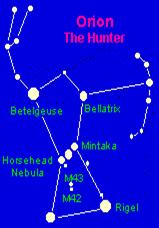 inter sky with his faithful dogs Canis Major and Canis Minor. Orion and his dogs hunt animals that have been placed nearby in the night sky, like Lepus, the rabbit and Taurus, the bull.
inter sky with his faithful dogs Canis Major and Canis Minor. Orion and his dogs hunt animals that have been placed nearby in the night sky, like Lepus, the rabbit and Taurus, the bull.
There are several stories about this beautiful constellation, but the one I like best is from Greek mythology. This tale has Orion in love with Merope, one of the Seven Sisters who form the Pleiades, but Merope would have nothing to do with him. Orion was killed when he was stung by Scorpius the scorpion. The gods felt sorry for him, though, and placed him in the sky with his two hunting dogs and the animals he liked best to hunt. They also put Scorpius in the sky—but placed him opposite in the sky so that neither would appear at the same time—and Orion would never be stung by Scorpius again.
Orion is probably the second most recognizable pattern of stars in the sky (after the Big Dipper). Finding Orion in the winter sky should be no problem. Look towards the southern horizon for the three bright stars that make up Orion's belt (Alnitak, Alnilam, and Mintaka). The bright star that makes up his left shoulder is Betelgeuse. If Betelgeuse replaced our sun, its size would completely engulf the Earth and extend to Mars. There is an even brighter star in the opposite corner from Betelgeuse, called Rigel. This star is Orion's right knee. Rigel is the brightest star in Orion, and in fact, is the seventh brightest star in the heavens.
Orion is visible from late fall to early spring. When you find Orion, see if you can locate his bow to the right and his raised arm and club to the left. Once you find him, it's fun to try to find his companions—Lepus, Taurus, Canis Major, and Canis Minor. Pleiades is also nearby.
Choose the correct answer:
1) You can see Orion
a) in spring
b) in summer
c) in winter
d) in autumn
2) Orion is the ___ most recognizable pattern of stars in the sky.
a) first
b) second
c) third
d) fourth
3) Name five constellations that are located close to Orion.
4) What should you look for when first trying to locate Orion?
a) His club
b) His belt
c) His bow
d) His left shoulder
5) What is the name of the brightest star in Orion?
a) Betelgeuse
b) Rigel
c) Alnitak
d) Alnilam
Text 4 B
Locating the Circumpolar Constellations
By Shannon Jackson
When you look up at the night sky, what do you see? People from many cultures have looked up at night and used the star groups or constellations as they are called, to tell stories. Simple shepherds more than 5,000 years ago had many stories about the stars and constellations—and they couldn't even read or write. Some of the names sound strange because we still use the names given long ago. Want to learn some tips on how to find some of these pictures in the sky?
Five constellations are always in our northern sky. Other groupings appear seasonally, and then disappear as they fall below the horizon. There are five constellations, however, which seem to circle Polaris (po LAR us), also known as the North Star. The North Star always stays put while the other stars and constellations are moving. Polaris is marking the North Pole for you. Of eighty-eight constellations, five are circling the North Pole—so we say they are circumpolar (circling the pole). And because they are always in our night sky in the northern hemisphere, these five circumpolar are a good starting point in learning the constellations.
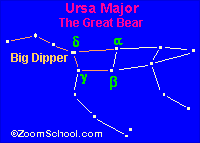
Choose a cloudless night. Begin your star connection with the most famous of all star pictures—Ursa Major, The Great Bear. Within this constellation is the Big Dipper. Some people think the Big Dipper is a constellation by itself—in fact; it is a part of this larger constellation Ursa Major.
The Big Dipper will help find all of the other constellations. In the fall, look fairly low in the northern sky for a large dipper with a crooked handle, made up of seven bright stars. These stars make up the main body and tail of the Great Bear. This group of stars is the one picture that looks the most like its name. A dipper is something people used long ago when they would get water from a well or bucket. It is important to remember, the Big Dipper will not be in the same position throughout the year. As the seasons change, it rotates around the sky. In the fall it is full of water. In the winter it looks like an icicle with the handle hanging down, springtime has the Dipper letting the water "rain down on us," and summertime has the Dipper dipping into the bucket to get us a drink on hot days.

We can use the "pointer stars" of the bowl in the Big Dipper to find Polaris. Pass over the first star you come to and go to the star next in line. This will be Polaris. If you can find Polaris, then you can now find the Little Dipper. It is also made up of seven stars, with the handle bent opposite of the handle in the Big Dipper. Polaris is the last star in the tip of the handle. This is part of the constellation Ursa Minor. Continue in a straight line from Polaris to the tip of the next constellation, Cepheus (SEE fee us). He looks like a house, his pointed hat being the roof. He was an ancient king who played an important part in Greek mythology and the husband of Cassiopeia (cass ee oh PEE a). We'll meet her next.
Cassiopeia is bright and easy to find in the sky. Sometimes she looks like W and sometimes like an M. Cassiopeia was ancient queen. This constellation, the Lady in the chair, is the second most easily found star picture in the sky. All of the five stars are almost the same brightness or magnitude.
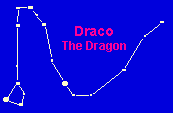
The fifth circumpolar constellation is Draco the Dragon. He is made up of faint stars, almost as if trying to conceal his presence as he lurks in the sky, ready to gobble up the king and queen. The easiest way to find Draco is to start with his tail. Go back to the star we skipped over when we were going from the Big Dipper to Polaris. That star is the tip of Draco's tail. He wraps around the Little Dipper. His head is a group of four stars that are directly in line with the bowl of the Little Dipper. There are fifteen stars in this constellation.
Finding the five circumpolar constellations in the real sky can be a challenge—just remember to start with the Big Dipper and go from there. Before long you will be ready to tackle finding the rest of the eighty-eight constellations.
Choose the correct answer:
1) group of stars are called ___
a) constellation
b) galaxy
c) Solar System
d) asteroids
2) There are five constellations, however, which seem to circle Polaris (po LAR us), also known as ___.
a) the North Star
b) Big Dipper
c) Ursa Minor
d) Cepheus
3) Another name of constellation Ursa Major is ___
a) The Great Bear
b) Big Dipper
c) Cepheus
d) the North Star
4) Dipper will be in the same position throughout the year.
a) True
b) False
5) Little Dipper made up of seven stars, with the handle bent opposite of the handle in the ___.
a) Big Dipper
b) Cepheus
c) the North Star
d) the Dragon
6) Draco the Dragon is made up of faint stars. His head is a group of stars that are directly in line with the bowl of the Little Dipper.
a) one
b) two
c) three
d) four
Text 4C
Pictures in the Stars
by Kelly Hashway
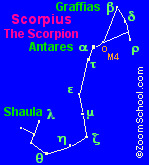
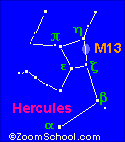
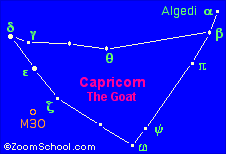
Have you ever stared at the clouds and tried to see pictures in them? Well, this is very similar to how ancient astronomers named the constellations.
Constellations are groups of stars, and today there are 88 officially recognized constellations. Each is named for a figure or object that astronomers saw when they viewed the star group. Most of the constellations are named after characters in mythology. Hercules, Draco, Orion, and The Great Bear are just a few. Others are named after the signs of the zodiac, like Sagittarius, Capricorn, and Scorpios. But the way they were named is very similar. Just like we look at clouds today and see figures and other objects, the astronomers looked at the stars and saw things.
But if you’ve ever played this cloud gazing game with your friends, you’ve probably noticed that different people see different things in the clouds. You may see a bear, while your best friend sees a lion in the very same cloud. This was also the case with naming the constellations. And as a result, the same constellation can be known by different names across the globe.
One of the best-known constellations is the Big Dipper. If you’ve ever seen it in the sky, then you know it looks like a scooper or a dipper. But the ancient Greeks called the Big Dipper “Ursa Major” or “Big Bear”. The ancient Irish and French called the Big Dipper the “Chariot,” and the British referred to it as the “Plough”. So you can see how star gazing and studying the constellations to find shapes in the patterns can cause a single constellation to have multiple names.
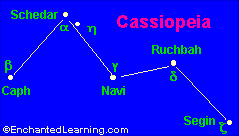
Another thing that contributes to these differing names is the expansion of the universe. The stars are moving and changing positions in the sky, which can make them, look less like what they were originally named and more like something completely different. The constellation Cassiopeia originally looked like a W, but today it appears to be a squiggly line. Astronomers believe that the Big Dipper will look like a number five in 50,000 years.
Imagine what you will see the next time you look at the stars.
Answer the questions:
1) What is a constellation?
a) a group of stars that are close to Earth
b) a group of stars that is named after a zodiac symbol
c) a group of stars that was named for a figure or object that ancient astronomers saw
d)a group of stars shaped like an unusual animal
2) How many officially recognized constellations are there?
3) Long ago, the constellation Cassiopeia was shaped like a W. Today it is shaped like a squiggly line. Why does it look different today than it did many years ago?
4) Complete each sentence below.
a) The ancient Greeks thought the Big Dipper looked like a ___.
b) Long ago, people of Britain thought the Big Dipper looked like a ___.
c) Ancient Irish and French people thought the big dipper looked like a ___.
Listening
“It's a Zoo Up There in Space. Make That a Galaxy Zoo”
Listen to the American radio program. This week, we tell about a project to identify images of one million galaxies that have been captured by the Sloan Digital Sky Survey. We also tell about the Perseid Meteor Shower. Complete the gaps:
1) NASA is observing Mars from orbit and also on its surface with the ___.
2) But there are objects in our solar system that remain mysterious. These are the asteroids and ___.
3) Astronomers believe that the force of gravity from ___ prevented the rocky material between it and Mars from forming a planet.
4) Ceres shares this classification with two other objects: Pluto and ___.
5) Astronomers believe that the outer covering of Ceres may contain up to twenty-five percent ___.
6) Vesta was the fourth object of its kind discovered. Astronomers believe it is covered with rock that melted and then became ___ again
7) Five percent of all meteorites we find on Earth might be from this one event on ___.
8) Dawn is a new kind of ___.
9) Dawn's engines use what is called an ion propulsion ___.
10) Dawn's eyes are two cameras that are exactly alike. They can measure light in seven different ___.
11) Researchers spend millions of dollars on equipment and tools they need to observe the ___.
12) The comet takes about ___ years to go around the sun, and leaves dust in its path.
13) People in big cities will be able to see the brightest meteors. But many, many more will be visible in the darkness of the countryside. The view this year will be especially good, because there will be very little ___.
14) Earth grazers are meteors that show up on the horizon and then trail overhead. A NASA official described them as “long, slow and ___.”
15) Professional astronomers have collected pictures of one million galaxies in our universe. These pictures came from a project called the Sloan Digital ___ Survey.
16) Astronomers want people around the world to help look at the pictures of the galaxies on a Web site and classify them into different kinds. All you need is a computer with connection to the Internet. This project is called ___.
17) Scientists say that knowing how many of each kind of galaxy there are will help them understand more about our universe. The information will help answer questions about how galaxies are made and how they ___.
Unit 5
Planets and the Sun
Start thinking!
1What planet is the closest to the Sun?
2 What planet is the largest in Solar System?
3 What planet is the farthest planet from the Sun?
4 Which one is called “red planet”?
Label the Solar System Diagram:
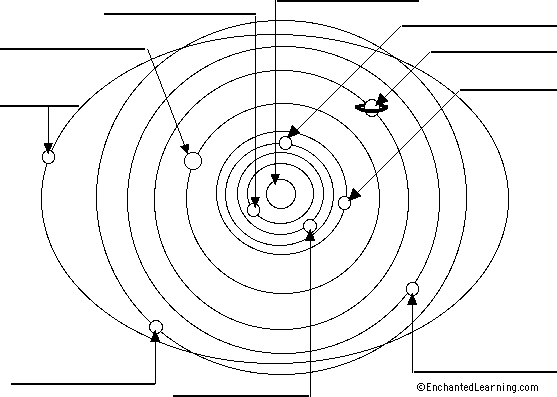
Reading 1
Read the article about planets and check your diagram.
Text 5A
Planets
MERCURY: planet Closest to the Sun
Temperature variations on Mercury are the most extreme in the solar system ranging from –170ғ C (–270ғ F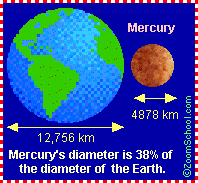 ) to 430ғ C (800ғ F). Mercury is the second smallest planet in the solar system. Only Pluto is smaller. Mercury is about the same size as our Moon. It is very close to the Sun. Mercury travels around the Sun faster than any other planet. It was named after Mercury, the swift messenger of the Roman gods. Mercury takes 59 days to make a rotation but only 88 days to circle the Sun. That means that there are fewer than 2 days in a year! Mercury can only be seen from Earth just before sunrise or just after sunset, but not in the middle of the night, because it always appears near the Sun. Mercury has a very thin atmosphere. The surface of Mercury has holes in it where objects such as meteorites and asteroids crashed into it.
) to 430ғ C (800ғ F). Mercury is the second smallest planet in the solar system. Only Pluto is smaller. Mercury is about the same size as our Moon. It is very close to the Sun. Mercury travels around the Sun faster than any other planet. It was named after Mercury, the swift messenger of the Roman gods. Mercury takes 59 days to make a rotation but only 88 days to circle the Sun. That means that there are fewer than 2 days in a year! Mercury can only be seen from Earth just before sunrise or just after sunset, but not in the middle of the night, because it always appears near the Sun. Mercury has a very thin atmosphere. The surface of Mercury has holes in it where objects such as meteorites and asteroids crashed into it.
Listening
“Why Do the Planets Orbit the Sun?”
You are going to listen to New Millennium Program. Dr. Marc Rayman, a scientist at the Jet Propulsion Laboratory answers questions from our Space Place museum partners across the nation. Answer the questions:
1) Why do the planets orbit the Sun?
2) But if the Sun is pulling the planets, why don't they just fall into the Sun and burn up?
3) So is this sideways motion partly why we need rockets to launch a spacecraft into orbit?
4) Why do some spacecraft fly close to Jupiter when it isn’t even close to their destination?
5) So isn’t there any other way to make spacecraft go faster? Can’t we just “step on the gas” a little more?
Unit 4
Constellations
Text 4A
The Mighty Hunter in the Winter Sky
By Shannon Jackson
I'd like to introduce you to one of my special friends. I only see him in the winter—and only when the sky is clear of clouds. He is a mighty hunter who has been placed in the w
 inter sky with his faithful dogs Canis Major and Canis Minor. Orion and his dogs hunt animals that have been placed nearby in the night sky, like Lepus, the rabbit and Taurus, the bull.
inter sky with his faithful dogs Canis Major and Canis Minor. Orion and his dogs hunt animals that have been placed nearby in the night sky, like Lepus, the rabbit and Taurus, the bull.There are several stories about this beautiful constellation, but the one I like best is from Greek mythology. This tale has Orion in love with Merope, one of the Seven Sisters who form the Pleiades, but Merope would have nothing to do with him. Orion was killed when he was stung by Scorpius the scorpion. The gods felt sorry for him, though, and placed him in the sky with his two hunting dogs and the animals he liked best to hunt. They also put Scorpius in the sky—but placed him opposite in the sky so that neither would appear at the same time—and Orion would never be stung by Scorpius again.
Orion is probably the second most recognizable pattern of stars in the sky (after the Big Dipper). Finding Orion in the winter sky should be no problem. Look towards the southern horizon for the three bright stars that make up Orion's belt (Alnitak, Alnilam, and Mintaka). The bright star that makes up his left shoulder is Betelgeuse. If Betelgeuse replaced our sun, its size would completely engulf the Earth and extend to Mars. There is an even brighter star in the opposite corner from Betelgeuse, called Rigel. This star is Orion's right knee. Rigel is the brightest star in Orion, and in fact, is the seventh brightest star in the heavens.
Orion is visible from late fall to early spring. When you find Orion, see if you can locate his bow to the right and his raised arm and club to the left. Once you find him, it's fun to try to find his companions—Lepus, Taurus, Canis Major, and Canis Minor. Pleiades is also nearby.
Choose the correct answer:
1) You can see Orion
a) in spring
b) in summer
c) in winter
d) in autumn
2) Orion is the ___ most recognizable pattern of stars in the sky.
a) first
b) second
c) third
d) fourth
3) Name five constellations that are located close to Orion.
4) What should you look for when first trying to locate Orion?
a) His club
b) His belt
c) His bow
d) His left shoulder
5) What is the name of the brightest star in Orion?
a) Betelgeuse
b) Rigel
c) Alnitak
d) Alnilam
Text 4 B
Locating the Circumpolar Constellations
By Shannon Jackson
When you look up at the night sky, what do you see? People from many cultures have looked up at night and used the star groups or constellations as they are called, to tell stories. Simple shepherds more than 5,000 years ago had many stories about the stars and constellations—and they couldn't even read or write. Some of the names sound strange because we still use the names given long ago. Want to learn some tips on how to find some of these pictures in the sky?
Five constellations are always in our northern sky. Other groupings appear seasonally, and then disappear as they fall below the horizon. There are five constellations, however, which seem to circle Polaris (po LAR us), also known as the North Star. The North Star always stays put while the other stars and constellations are moving. Polaris is marking the North Pole for you. Of eighty-eight constellations, five are circling the North Pole—so we say they are circumpolar (circling the pole). And because they are always in our night sky in the northern hemisphere, these five circumpolar are a good starting point in learning the constellations.

Choose a cloudless night. Begin your star connection with the most famous of all star pictures—Ursa Major, The Great Bear. Within this constellation is the Big Dipper. Some people think the Big Dipper is a constellation by itself—in fact; it is a part of this larger constellation Ursa Major.
The Big Dipper will help find all of the other constellations. In the fall, look fairly low in the northern sky for a large dipper with a crooked handle, made up of seven bright stars. These stars make up the main body and tail of the Great Bear. This group of stars is the one picture that looks the most like its name. A dipper is something people used long ago when they would get water from a well or bucket. It is important to remember, the Big Dipper will not be in the same position throughout the year. As the seasons change, it rotates around the sky. In the fall it is full of water. In the winter it looks like an icicle with the handle hanging down, springtime has the Dipper letting the water "rain down on us," and summertime has the Dipper dipping into the bucket to get us a drink on hot days.

We can use the "pointer stars" of the bowl in the Big Dipper to find Polaris. Pass over the first star you come to and go to the star next in line. This will be Polaris. If you can find Polaris, then you can now find the Little Dipper. It is also made up of seven stars, with the handle bent opposite of the handle in the Big Dipper. Polaris is the last star in the tip of the handle. This is part of the constellation Ursa Minor. Continue in a straight line from Polaris to the tip of the next constellation, Cepheus (SEE fee us). He looks like a house, his pointed hat being the roof. He was an ancient king who played an important part in Greek mythology and the husband of Cassiopeia (cass ee oh PEE a). We'll meet her next.
Cassiopeia is bright and easy to find in the sky. Sometimes she looks like W and sometimes like an M. Cassiopeia was ancient queen. This constellation, the Lady in the chair, is the second most easily found star picture in the sky. All of the five stars are almost the same brightness or magnitude.

The fifth circumpolar constellation is Draco the Dragon. He is made up of faint stars, almost as if trying to conceal his presence as he lurks in the sky, ready to gobble up the king and queen. The easiest way to find Draco is to start with his tail. Go back to the star we skipped over when we were going from the Big Dipper to Polaris. That star is the tip of Draco's tail. He wraps around the Little Dipper. His head is a group of four stars that are directly in line with the bowl of the Little Dipper. There are fifteen stars in this constellation.
Finding the five circumpolar constellations in the real sky can be a challenge—just remember to start with the Big Dipper and go from there. Before long you will be ready to tackle finding the rest of the eighty-eight constellations.
Choose the correct answer:
1) group of stars are called ___
a) constellation
b) galaxy
c) Solar System
d) asteroids
2) There are five constellations, however, which seem to circle Polaris (po LAR us), also known as ___.
a) the North Star
b) Big Dipper
c) Ursa Minor
d) Cepheus
3) Another name of constellation Ursa Major is ___
a) The Great Bear
b) Big Dipper
c) Cepheus
d) the North Star
4) Dipper will be in the same position throughout the year.
a) True
b) False
5) Little Dipper made up of seven stars, with the handle bent opposite of the handle in the ___.
a) Big Dipper
b) Cepheus
c) the North Star
d) the Dragon
6) Draco the Dragon is made up of faint stars. His head is a group of stars that are directly in line with the bowl of the Little Dipper.
a) one
b) two
c) three
d) four
Text 4C
Pictures in the Stars
by Kelly Hashway



Have you ever stared at the clouds and tried to see pictures in them? Well, this is very similar to how ancient astronomers named the constellations.
Constellations are groups of stars, and today there are 88 officially recognized constellations. Each is named for a figure or object that astronomers saw when they viewed the star group. Most of the constellations are named after characters in mythology. Hercules, Draco, Orion, and The Great Bear are just a few. Others are named after the signs of the zodiac, like Sagittarius, Capricorn, and Scorpios. But the way they were named is very similar. Just like we look at clouds today and see figures and other objects, the astronomers looked at the stars and saw things.
But if you’ve ever played this cloud gazing game with your friends, you’ve probably noticed that different people see different things in the clouds. You may see a bear, while your best friend sees a lion in the very same cloud. This was also the case with naming the constellations. And as a result, the same constellation can be known by different names across the globe.
One of the best-known constellations is the Big Dipper. If you’ve ever seen it in the sky, then you know it looks like a scooper or a dipper. But the ancient Greeks called the Big Dipper “Ursa Major” or “Big Bear”. The ancient Irish and French called the Big Dipper the “Chariot,” and the British referred to it as the “Plough”. So you can see how star gazing and studying the constellations to find shapes in the patterns can cause a single constellation to have multiple names.

Another thing that contributes to these differing names is the expansion of the universe. The stars are moving and changing positions in the sky, which can make them, look less like what they were originally named and more like something completely different. The constellation Cassiopeia originally looked like a W, but today it appears to be a squiggly line. Astronomers believe that the Big Dipper will look like a number five in 50,000 years.
Imagine what you will see the next time you look at the stars.
Answer the questions:
1) What is a constellation?
a) a group of stars that are close to Earth
b) a group of stars that is named after a zodiac symbol
c) a group of stars that was named for a figure or object that ancient astronomers saw
d)a group of stars shaped like an unusual animal
2) How many officially recognized constellations are there?
3) Long ago, the constellation Cassiopeia was shaped like a W. Today it is shaped like a squiggly line. Why does it look different today than it did many years ago?
4) Complete each sentence below.
a) The ancient Greeks thought the Big Dipper looked like a ___.
b) Long ago, people of Britain thought the Big Dipper looked like a ___.
c) Ancient Irish and French people thought the big dipper looked like a ___.
Listening
“It's a Zoo Up There in Space. Make That a Galaxy Zoo”
Listen to the American radio program. This week, we tell about a project to identify images of one million galaxies that have been captured by the Sloan Digital Sky Survey. We also tell about the Perseid Meteor Shower. Complete the gaps:
1) NASA is observing Mars from orbit and also on its surface with the ___.
2) But there are objects in our solar system that remain mysterious. These are the asteroids and ___.
3) Astronomers believe that the force of gravity from ___ prevented the rocky material between it and Mars from forming a planet.
4) Ceres shares this classification with two other objects: Pluto and ___.
5) Astronomers believe that the outer covering of Ceres may contain up to twenty-five percent ___.
6) Vesta was the fourth object of its kind discovered. Astronomers believe it is covered with rock that melted and then became ___ again
7) Five percent of all meteorites we find on Earth might be from this one event on ___.
8) Dawn is a new kind of ___.
9) Dawn's engines use what is called an ion propulsion ___.
10) Dawn's eyes are two cameras that are exactly alike. They can measure light in seven different ___.
11) Researchers spend millions of dollars on equipment and tools they need to observe the ___.
12) The comet takes about ___ years to go around the sun, and leaves dust in its path.
13) People in big cities will be able to see the brightest meteors. But many, many more will be visible in the darkness of the countryside. The view this year will be especially good, because there will be very little ___.
14) Earth grazers are meteors that show up on the horizon and then trail overhead. A NASA official described them as “long, slow and ___.”
15) Professional astronomers have collected pictures of one million galaxies in our universe. These pictures came from a project called the Sloan Digital ___ Survey.
16) Astronomers want people around the world to help look at the pictures of the galaxies on a Web site and classify them into different kinds. All you need is a computer with connection to the Internet. This project is called ___.
17) Scientists say that knowing how many of each kind of galaxy there are will help them understand more about our universe. The information will help answer questions about how galaxies are made and how they ___.
Unit 5
Planets and the Sun
Start thinking!
1What planet is the closest to the Sun?
2 What planet is the largest in Solar System?
3 What planet is the farthest planet from the Sun?
4 Which one is called “red planet”?
Label the Solar System Diagram:

Reading 1
Read the article about planets and check your diagram.
Text 5A
Planets
MERCURY: planet Closest to the Sun
Temperature variations on Mercury are the most extreme in the solar system ranging from –170ғ C (–270ғ F
 ) to 430ғ C (800ғ F). Mercury is the second smallest planet in the solar system. Only Pluto is smaller. Mercury is about the same size as our Moon. It is very close to the Sun. Mercury travels around the Sun faster than any other planet. It was named after Mercury, the swift messenger of the Roman gods. Mercury takes 59 days to make a rotation but only 88 days to circle the Sun. That means that there are fewer than 2 days in a year! Mercury can only be seen from Earth just before sunrise or just after sunset, but not in the middle of the night, because it always appears near the Sun. Mercury has a very thin atmosphere. The surface of Mercury has holes in it where objects such as meteorites and asteroids crashed into it.
) to 430ғ C (800ғ F). Mercury is the second smallest planet in the solar system. Only Pluto is smaller. Mercury is about the same size as our Moon. It is very close to the Sun. Mercury travels around the Sun faster than any other planet. It was named after Mercury, the swift messenger of the Roman gods. Mercury takes 59 days to make a rotation but only 88 days to circle the Sun. That means that there are fewer than 2 days in a year! Mercury can only be seen from Earth just before sunrise or just after sunset, but not in the middle of the night, because it always appears near the Sun. Mercury has a very thin atmosphere. The surface of Mercury has holes in it where objects such as meteorites and asteroids crashed into it.
